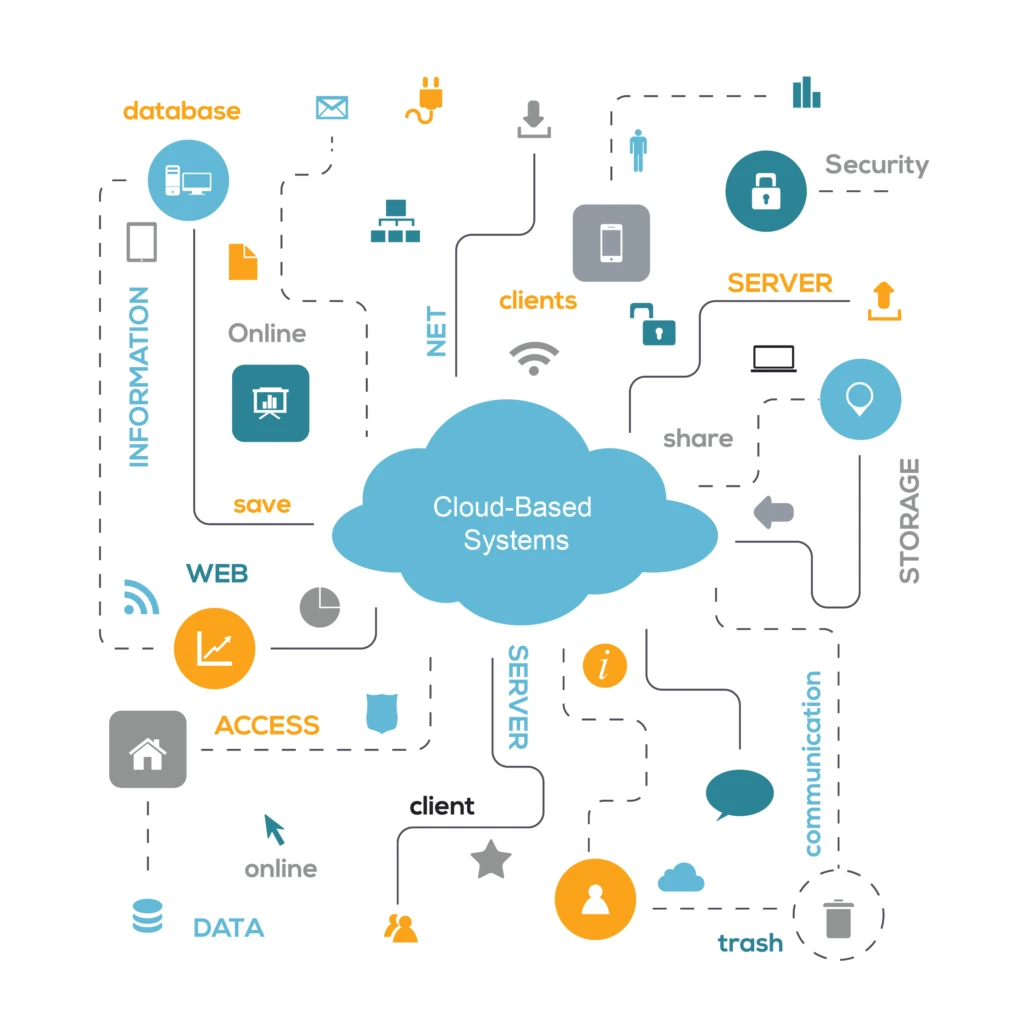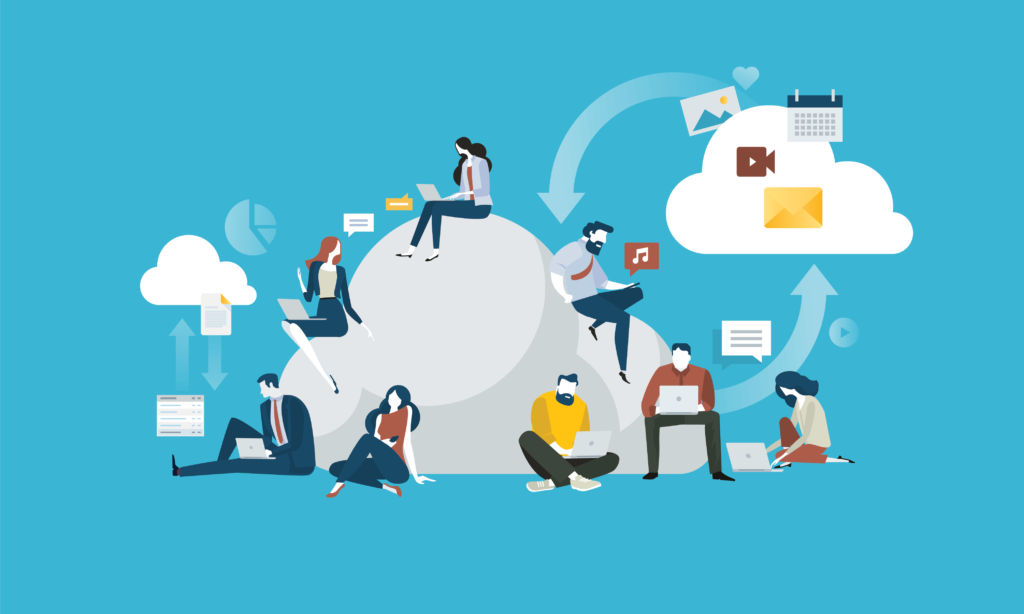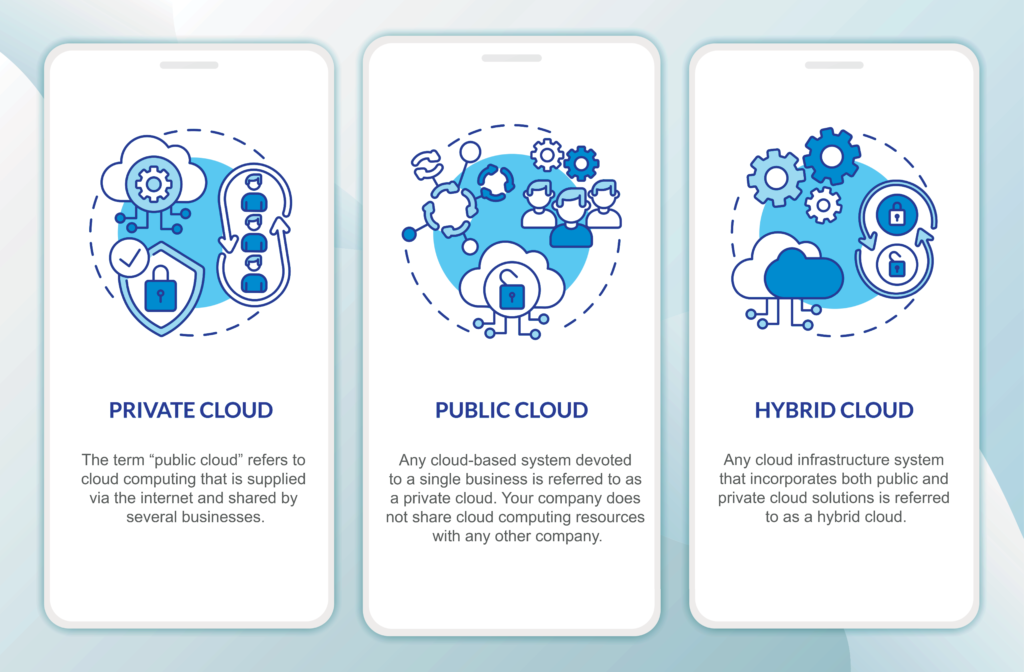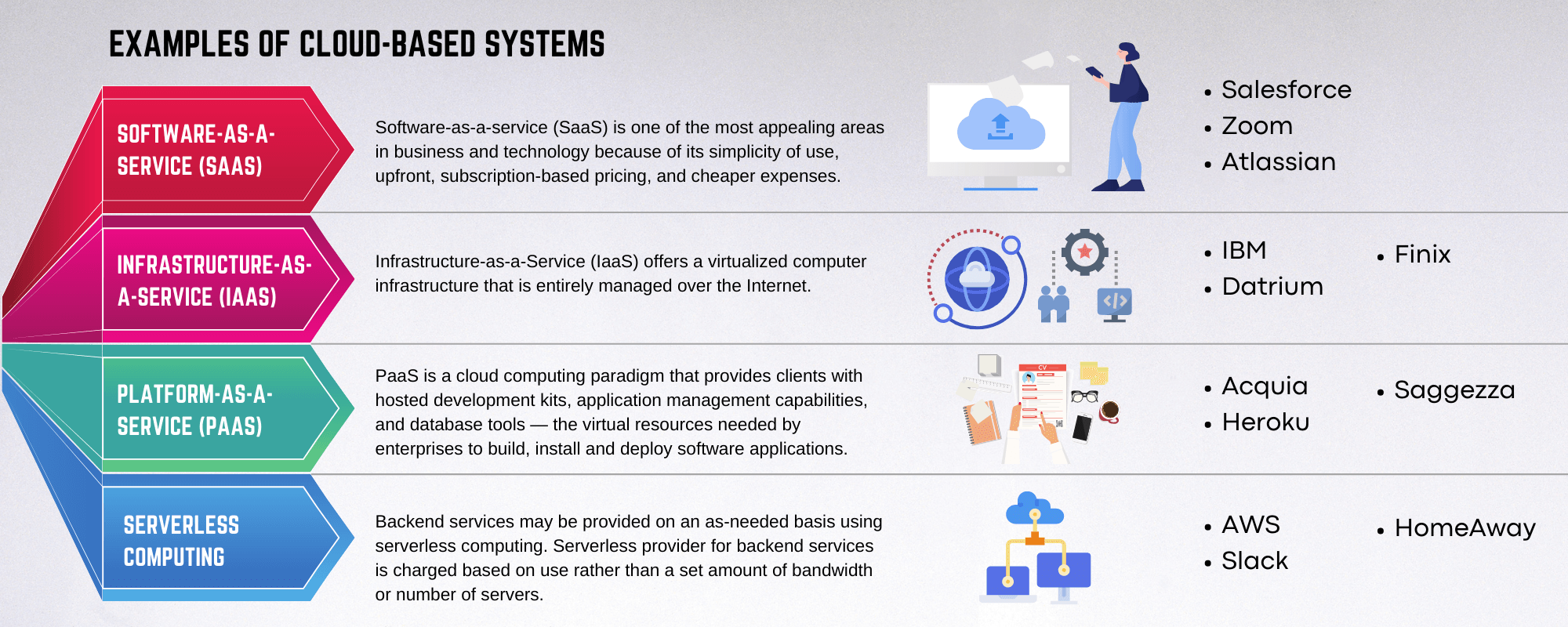
什么是云端系统?它是如何运作的?
基于云的系统,也被称为云计算,是一个广义术语,指的是通过互联网提供托管服务的所有方式。
云可以是私有的,也可以是公共的。公共云向任何可以访问互联网的人出售服务。
私有云是一个专有网络或数据中心,为一小部分具有有限访问权限和权限的用户提供服务。无论是私有云还是公共云,云计算的目标都是提供便捷的计算资源和信息技术服务。
2017年,联邦政府从“云优先”策略转向“云智能”计划,以加快各机构采用基于云的解决方案的速度,并提升其采用新技术的效率。如今,政府被广泛认为是云计算技术最活跃的用户。
什么是基于云的系统?它对您的业务到底有多大帮助?在这篇关于基于云的系统的深入指南中,我们将介绍这些系统的定义、示例、用途及其优势。

历史概念:数据、客户端、服务器、数据库
基于云的系统简史
“云计算”一词最早出现在1996年康柏公司的一份内部文件中。而“云”这一概念最早与分布式计算相关,最初在1990年代初期由 Apple 衍生出的 General Magic 推广,早前也在学术论文中出现过。
随着1990年代计算技术成本的下降,大量个人计算机开始联网。1999年,Salesforce 成为第一家通过互联网提供软件的公司,开启了“软件即服务”(SaaS)时代。
不到三年,该行业便迅速扩展,涵盖视频、音乐等在线存储和传输的内容形式。
随着用户体验设计(UX)的兴起,非技术人员也能访问原本只有程序员和代码专家才能获取的数据。
到了1990年代中期,“云”这一术语已经被用来描述这个新的数字领域。Google 和 Microsoft 很快开始争夺这一虚拟领域的市场份额。
“云”迅速普及,而平台即服务(PaaS)、软件即服务(SaaS)和基础设施即服务(IaaS)的发展催生了一个全新的行业——网络安全企业。
到了2010年,几乎每个人都在娱乐、医疗、银行和政府领域使用云服务。加入这一新兴行业的浪潮席卷而来,云计算带来了人类历史上前所未有的文化变革。
随着知识壁垒的消除和信息获取变得更加广泛和便捷,许多伟大的创意开始从最普通的地方涌现。小型企业正在重新塑造世界。财富在偏远地区得以创造,个人的发明和创造力成为每个人都可实现的目标。

基于云的系统今天如何应用?
随着我们继续探索这个新科技时代的发展,基于云的系统在社会上的益处不断显现。随着越来越多复杂的应用不再局限于物理位置而得以释放,这一发展正以指数级增长。
我们已经见证了从软盘到Zip驱动器、CD(和数据DVD)再到USB存储设备的演进。而对千禧一代来说,云技术似乎理所当然地属于他们,但非本地计算的根源可追溯到1950年代初。
公共云解决方案的优势包括成本较低、维护较少,以及几乎无限的可扩展性,但由于缺乏严格的数据安全性和无法满足合规要求,它们并不适用于受监管行业的企业。
换句话说,随着云技术的发展和越来越多的企业迁移到基于云的服务,了解行业内的最新趋势变得尤为重要。
根据 Forrester Research 的数据,全球公共云基础设施市场将在2021年增长35%,达到1200亿美元,因为云服务在疫情恢复过程中“成为核心”。

基于云系统的主要优势
企业之所以纷纷转向云端,原因有很多。以下是基于云系统的主要优势:
1. 成本
基于云的系统的成本在很大程度上取决于您所需的云服务类型。基于云的软件费用也取决于其所面向的行业。其他影响成本的因素包括用户数量、程序在组织内的部署和分发方式,以及技术支持优先级的选择。
根据 Healthy IT 的说法,若为您的小型企业购买服务器,预算应为 $1,000–$3,000;而若选择租用云服务器,每月只需预算 $100–$200,甚至更低。对许多小企业来说,选择非常简单:租用。
如果您倾向于按需付费、按月订阅的方式,仅支付所需的存储空间,那就选择经济型云存储。如果您不希望花时间去考虑硬件更新和维护,云存储也是理想选择。
2. 灵活性
云计算使您的员工更加灵活——无论是在办公室内外。员工可通过具备网络功能的设备(如手机、笔记本电脑和平板)访问文件。
通过互联网共享文件和其他数据,还可以帮助企业实现内部和外部的协作。如今,越来越多的工作场所正在实施“自带设备(BYOD)”政策。云计算在此方面极大地促进了移动技术的应用。
3. 性能
云性能监控和测试解决方案帮助企业通过特定的指标和方法评估性能,从而洞察其云环境。
高效的云性能对于确保业务连续性和为所有相关方提供云服务访问至关重要。这对于简单的公共云使用,以及复杂的混合云和多云系统都同样适用。
云性能指标使您可以高效地监控云资源,并确保所有组件彼此顺畅协作。
4. 安全性
对于正向云端转型的企业而言,云安全至关重要。安全风险不断演变且日益复杂,云计算并不比本地系统更安全。因此,与一家能够为您的架构定制顶级安全措施的云服务提供商合作至关重要。
基于云的系统使企业能够实现规模化运营、降低技术成本,并利用灵活的系统获取竞争优势。另一方面,企业必须对云计算安全有充分的信任,并确保所有数据、系统和应用程序免受数据窃取、泄露、损坏或删除的威胁。

公共云、私有云和混合云的区别
云计算类型:公共云 vs 私有云 vs 混合云选项
云计算可分为不同的类别、类型和架构模式。这种网络计算模式已经改变了我们的工作方式——您很可能已经在使用云了。但云并非单一实体。云计算大致可分为三类:
- “公共云”是指通过互联网提供并由多个企业共享的云计算服务。
- “私有云”是专门为某一家公司提供的云计算服务。
- 任何同时使用公共云和私有云的组合都称为“混合云”。
公共云
公共云是指通过互联网提供 IT 服务的云计算模式。它是最常见的一种云计算服务类型,为不同规模和行业的公司提供大量解决方案和计算资源,以满足不断增长的需求。
私有云
任何专为某一家企业而设的云系统都称为私有云。您的企业不会与其他公司共享云计算资源。
数据中心资源可以部署在本地或外包给第三方管理。计算资源通过安全的私有网络提供,彼此独立,且不与其他客户共享。
混合云
混合云是指同时采用公共云和私有云解决方案的任何云基础设施系统。
企业可以在私有云环境中运行 IT 工作负载,同时在网络流量激增时使用公共云资源进行扩展补充。

基于云系统的示例
软件即服务(SaaS)
软件即服务(SaaS)可以说是云计算中最广为人知的应用。SaaS 解决方案通过网络分发数据,可通过任何设备上的浏览器访问,使企业能够持续托管软件。
SaaS 之所以在商业和技术领域如此受欢迎,是因为其使用便捷、采用预付的订阅定价模式且整体费用更低。
Salesforce
Salesforce 是知名的 SaaS 提供商,提供 CRM 系统,帮助企业管理客户关系并生成销售线索。其 Sales Cloud 结合人工智能与客户数据,帮助销售团队识别潜在客户并加快成交速度。该平台还提供用于客户支持与营销的不同云服务。
Zoom
Zoom 是一款基于云的音视频会议平台,可录制会议并将其保存在云端,用户可随时随地查看。
Atlassian
Atlassian 提供 SaaS 工具,协助从小型企业到大型企业的各类组织跨部门简化工作流程,帮助员工更好地对齐目标。
基础设施即服务(IaaS)
基础设施即服务(IaaS)提供完全通过互联网管理的虚拟计算基础架构。IaaS 通常用于应用开发测试环境、网站托管,甚至是大数据研究平台。凭借其业务连续性和快速的软件交付,IaaS 正成为流行的云选择。
IBM
虽然 IBM 提供的云系统形式多样,但其大多数 IaaS 服务器可在几分钟到数小时内设置完成。其“裸金属服务器”支持高达 3GB 的项目并可在数小时内部署,而“虚拟服务器”则适合需要灵活性且可扩展的应用,几分钟即可完成部署。
Datrium
Datrium 是一家结合数据管理与云计算的公司。其 IaaS 云具备增强的网络安全功能,包括全方位验证、内置数据备份和数据安全防护。
Finix
Finix 平台允许软件公司、独立软件供应商(ISV)和市场平台简化内部支付流程,将网关/令牌化、商户注册、报告、结算和拒付处理整合为一个平台。
平台即服务(PaaS)
PaaS 是一种云计算模式,向客户提供托管的开发工具包、应用管理功能和数据库工具——企业构建、安装和部署软件应用所需的虚拟资源。通过外包托管、数据库安全和数据存储,企业可以长期节省大量成本。
Saggezza
Saggezza 提供全栈解决方案,帮助企业解决其最具挑战性的问题,包括咨询、用户体验设计、分析、云服务和 IT 优化服务,通过技术手段带来竞争优势。
Acquia
Acquia Cloud 专为 Drupal 8 网站和应用程序设计。这项 PaaS 技术对开发者友好,提供 API、命令行工具和连接器,帮助加快开发流程。
Heroku
Heroku 是一个云应用平台,允许开发者使用多种语言构建、扩展和管理应用。Heroku 的 PaaS 灵活性支持 Ruby、Java、Python、Perl 等语言。据报道,允许开发者使用熟悉的语言有助于加快应用开发速度。
无服务器计算
无服务器计算可根据实际需求提供后端服务。虽然仍使用服务器,但企业使用无服务器服务商提供后端服务时,是根据使用量而非固定带宽或服务器数量计费的。
Amazon Web Services (AWS)
AWS Lambda 让开发者可以无需部署或维护服务器即可运行任意应用或后端服务的代码。按使用量付费的模式可随企业扩展,适应数据存储和使用的实时变化。
Slack
Slack 是一个团队和企业协作平台。Slack 频道是按个人、团队、项目或主题等方式组织的通信分组,确保所有人顺畅沟通。
作为基于云的系统与 SaaS 提供商,Slack 还提供视频会议、PDF 文件共享,以及与 Dropbox 和 Salesforce 等其他云服务的集成。
HomeAway
缩短开发时间、降低服务器成本、简化构建流程是企业与 IT 团队共同追求的目标。HomeAway 使用 Google Cloud Functions 构建了一款 App,即便在离线状态下,用户也可以实时浏览与评论旅行建议。
通过 Cloud Firestore 和 Cloud Functions 提供的云服务,基础架构可在几分钟内设置完毕,整个 App 仅用一名全职开发者在六周内成功部署上线。
总结
在选择云服务提供商时,应综合权衡多个因素。虽然基于云的系统通常采用按使用量计费模式,但不同服务商的定价方案也需仔细考量。
此外,如果服务商将存储敏感数据,服务商服务器的实际物理位置也应纳入考虑范围。
云计算的优势不仅体现在大幅减少纸张使用方面,还在于提高能效。
迁移到云端不仅更加经济实惠、部署简单、安全高效,也更环保。提供随时随地访问程序与数据的云端工作环境,有助于减少与通勤相关的碳排放。
A cloud-based system, often known as cloud computing, is a broad term for anything that involves the delivery of hosted services via the internet.
A cloud can be either private or public. A public cloud sells services to anybody who has access to the internet.
A private cloud is a proprietary network or data center that provides services for a small group of individuals with limited access and rights. Cloud computing, whether private or public, aims to give easy access to computer resources and information technology services.
In 2017, the federal government shifted from a “Cloud First” approach to a “Cloud Smart” plan to expedite agency adoption of cloud-based solutions and enhance the speed with which their agencies adopt the new technology. The government is now often regarded as the most active user of cloud computing technologies.
What is a cloud-based system and just how beneficial can it be for your business? In this in-depth guide about cloud-based systems, we will cover what these systems are, provide some examples, explain what they are used for, and their benefits.

History concept data, clients, server, database
Brief History Of Cloud-Based Systems
The phrase “cloud computing” was first used in a Compaq internal document in 1996. The term “cloud” was first linked with the concept of distributed computing, which gained popularity at Apple-spawned General Magic in the early 1990s, with preceding references in academic work.
As computer technology costs decreased in the 1990s, a large number of personal computers were connected to networks. In 1999, Salesforce became the first company to offer software via the internet, bringing in the era of Software as a Service.
Within three years, the business had dramatically expanded to include video, music, and other forms of material being housed and supplied online.
With the advent of UX design, non-technologists gained access to data that had previously been exclusively available to programmers and code literates.
By the mid-1990s, the phrase “the cloud” had already been used to describe this new digital realm. Google and Microsoft soon found themselves in a race to get a larger part of this virtual environment’s market share.
The cloud was suddenly ubiquitous, and the growth of PaaS (Platform-as-a-Service), SaaS (Software-as-a-Service), and IaaS (Infrastructure-as-a-Service) created a completely new sector: the cyber-security enterprise.
By 2010, nearly everyone was using the cloud for entertainment, healthcare, banking, and government. A gold rush to join this new industry was underway. The cloud was causing a cultural change never before witnessed in human history.
As knowledge barriers lifted and access to information grew more widespread and simple, great things began to emerge from the most modest of settings. Small businesses were reshaping the globe. Wealth was generated in faraway areas, and individual invention and ingenuity became the realm of the individual.
how cloud based systems work concept

How Are Cloud-Based Systems Used Today?
As we continue to investigate how our new technology era is growing, the societal benefits of a cloud-based system are constantly revealed. This development is growing exponentially as ever more complicated applications are released from use in a single physical place.
We have witnessed the evolution from floppy disks to zip drives, CDs (and data DVDs) to USB storage devices, and beyond. While Millennials feel the cloud belongs to them, the roots of non-local computing may be traced back to the early 1950s.
Public cloud solutions provide advantages such as cheaper prices, less maintenance, and nearly limitless scalability but they are not a choice for enterprises in regulated industries due to their lack of rigorous data security and inability to meet compliance requirements.
This means, in much simpler terms, that as cloud technologies advance and more businesses migrate to cloud-based services, it is important to grasp the growing trends in the industry.
According to Forrester Research, the worldwide public cloud infrastructure market will grow by 35% to $120 billion by 2021, as the cloud continues to “take center stage” in the pandemic recovery.
Benefits of a virtual based phone systems for remote workers

Top Benefits Of Cloud-Based Systems
Businesses are moving towards the cloud for several reasons. Here are the top benefits of cloud-based systems:
1. Cost
A cloud-based system costs largely depend on the type of cloud service you need. The cost of cloud-based software is also determined by the industry for which it is designed. Other considerations that influence cost include the number of users, how the program will be launched and distributed throughout the organization, and priority tech-support choices.
According to Healthy IT, to purchase a server for your small practice, you should budget $1,000–$3,000 upfront; and to rent a cloud server, you should budget $100–$200 per month, or even less. For many small companies, the decision is simple: rent.
If the concept of paying just for the quantity of storage you require in set monthly subscriptions appeals to you, go with cheap cloud storage. Cloud storage is also ideal if you don’t want to spend time thinking about hardware updates and upkeep.
2. Flexibility
Cloud computing enables your employees to be more flexible – both within and outside of the office. Employees can access files via web-enabled devices including cell phones, laptops, and notebook computers.
The capacity to exchange documents and other data via the Internet can also aid in internal and external cooperation. Many workplaces are increasingly enforcing “bring your own device (BYOD)” rules. Cloud computing facilitates the use of mobile technologies in this fashion.
3. Performance
Cloud performance monitoring and testing solutions assist companies in gaining visibility into their cloud environments by assessing performance using particular metrics and methodologies.
Efficient cloud performance is important for guaranteeing business continuity and providing access to cloud services to all relevant parties. This is true for both simple public cloud usage and complicated hybrid cloud and multi-cloud systems.
Cloud performance metrics allow you to efficiently monitor your cloud resources and guarantee that all components smoothly interact with one another.
4. Security
Cloud security is essential for companies that are transitioning to the cloud. Security risks are always changing and becoming more complex, and cloud computing is no less vulnerable than on-premise systems. Working with a cloud provider that offers best-in-class security that is customized to your architecture is important.
A cloud-based system enables companies to operate at scale, cut technological expenses, and leverage flexible systems to gain a competitive advantage. Companies, on the other hand, must have total trust in their cloud computing security and ensure that all data, systems, and applications are safe against data theft, leakage, corruption, and deletion.

Public, private and hybrid cloud – what’s the difference
Cloud Computing Types: Public vs Private vs Hybrid Cloud Options
Cloud computing refers to a variety of categories, types, and architecture models. This networked computer paradigm has changed the way we work—you’ve probably already used the cloud. But the cloud isn’t just one entity. Cloud computing may be divided into three broad categories:
The term “public cloud” refers to cloud computing that is supplied via the internet and shared by several businesses.
Private cloud computing is cloud computing that is entirely dedicated to your company.
Any arrangement that employs both public and private clouds is referred to as a hybrid cloud.
Public Cloud
The cloud computing approach in which IT services are offered through the internet is referred to as the public cloud. The public cloud, the most common type of cloud computing service, provides a plethora of solutions and computing resources to meet the rising demands of companies of all sizes and sectors.
Private Cloud
Any cloud-based system devoted to a single business is referred to as a private cloud. Your company does not share cloud computing resources with any other company.
The data center resources may be located on-site or off-site and might be managed by a third-party provider. The computer resources are separate and provided over a secure private network; they are not shared with other clients.
Hybrid
Any cloud infrastructure system that incorporates both public and private cloud solutions is referred to as a hybrid cloud.
Organizations can employ private cloud environments for IT workloads while supplementing the infrastructure with public cloud resources to handle rare surges in network traffic.

Examples of cloud based systems
Software-as-a-Service (SaaS)
Software-as-a-service is arguably the most well-known application of cloud computing (SaaS). In essence, SaaS solutions disseminate data online and are available from any browser on any device, allowing those businesses to continue hosting the software.
SaaS is one of the most appealing areas in business and technology because of its simplicity of use, upfront, subscription-based pricing, and cheaper expenses.
Salesforce
Salesforce, a well-known SaaS vendor, offers a CRM system that helps businesses manage customer connections and generate sales leads. The Sales Cloud blends artificial intelligence and customer data to assist deals teams in identifying prospective leads and more quickly closing sales. Distinct clouds are available for customer support and marketing on the platform.
Zoom
Zoom is a cloud-based audio and video conferencing software platform that captures meetings and saves them to the cloud for users to view at any time and from any location.
Atlassian
Atlassian creates SaaS tools that assist organizations ranging from small enterprises to large corporations in streamlining workflow across departments and better aligning employees to achieve goals.
Infrastructure-as-a-Service (IaaS)
Infrastructure-as-a-Service (IaaS) offers a virtualized computer infrastructure that is entirely managed over the Internet. IaaS is frequently used as a testing environment for app development, a website host, and even a platform for big data research. Because of its business continuity and speed in providing software, IaaS is becoming a popular cloud choice.
IBM
While the cloud-based system differs, most IBM IaaS servers can be set up in minutes to a few hours. The IT giant’s “bare metal servers” can support projects up to 3 gigabytes and can be deployed in a matter of hours. The “virtual servers” are ideal for scalable applications that demand flexibility and deploy in a matter of minutes.
Datrium
Datrium is a firm that combines data management with cloud computing. The IaaS cloud from the firm has increased cybersecurity capabilities such as blanket verification, built-in data backup, and data security safeguards.
Finix
The Finix platform allows software companies, ISVs, and marketplaces to streamline the process of bringing payments in-house by combining gateway/tokenization, merchant onboarding, reporting, settlement, and chargeback tools and solutions into a single platform.
Platform-as-a-Service (PaaS)
PaaS is a cloud computing paradigm that provides clients with hosted development kits, application management capabilities, and database tools — the virtual resources needed by enterprises to build, install and deploy software applications. Companies can save lots of money in the long run by outsourcing hosting, database security, and data storage.
Saggezza
Saggezza offers full-stack solutions to assist businesses in facing their most difficult issues, including consulting, UX, analytics, cloud, and IT optimization services to provide them with a competitive advantage through technology.
Acquia
The Acquia Cloud was designed particularly for Drupal 8 sites and apps. The PaaS technology is developer-friendly, providing APIs, command-line tools, and connectors to help developers expedite their development workflow.
Heroku
Heroku is a cloud app platform that allows developers to launch, grow, and manage their apps in many languages. Heroku’s PaaS versatility allows them to operate in languages such as Ruby, Java, Python, Perl, and others. Permitting developers to write in a familiar language, according to reports, speeds up app development.
Serverless Computing
Backend services may be provided on an as-needed basis using serverless computing. Servers are still used, but a company that employs a serverless provider for backend services is charged based on use rather than a set amount of bandwidth or number of servers.
Amazon Web Services (AWS)
AWS Lambda enables developers to run code for any application or backend service without the need for server deployment or maintenance. The pay-as-you-go approach grows with the business to meet real-time changes in data storage and consumption.
Slack
Slack is a team and company collaboration platform. Slack channels are simply grouped communications that may be arranged by individual, team, project, subject, and so on to ensure that everyone is able to communicate smoothly.
A cloud-based system and SaaS provider also provide video conferencing and PDF file sharing, as well as connectivity with other cloud providers like Dropbox and Salesforce.
HomeAway
Reducing development time and server costs while simplifying the build process are aims that both business and IT teams share. HomeAway used Google Cloud Functions to create an app that allowed users to browse and comment on traveler suggestions in real-time, even when no internet access was available.
The cloud services provided by Cloud Firestore and Cloud Functions enabled the infrastructure to be set up in minutes and the app to be deployed in six weeks with only one full-time developer.
The Bottom Line
Certain factors should be weighed when selecting a cloud service provider. Though cloud-based systems are usually based on a pay-per-use approach, various providers frequently have pricing schemes that must be considered.
Furthermore, if the cloud provider will keep sensitive data, the physical location of the provider’s servers should be taken into account.
The advantages of cloud computing extend beyond substantially reducing your paper consumption; cloud computing also adds to energy efficiency.
Moving to the cloud is not only more cost-effective, simple to deploy, secure, and productive, but it is also better for the environment. Cloud-powered workplaces that provide their employees with access to their programs and data at any time and from any location help reduce commuting-related carbon emissions.